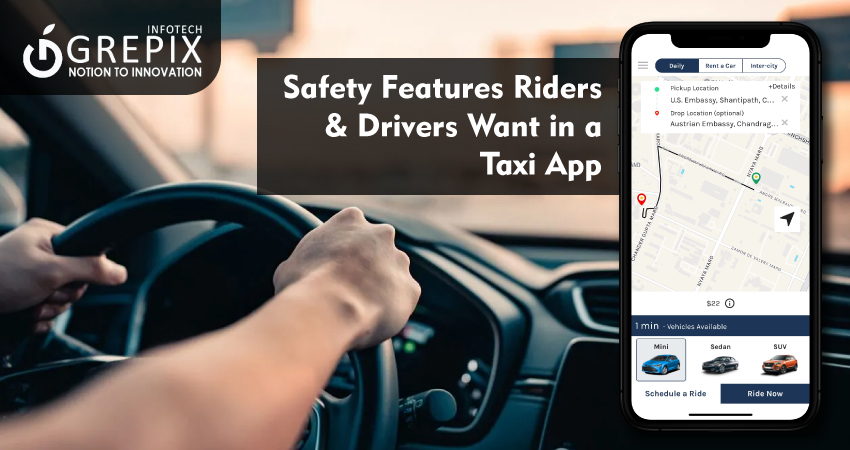Safety Features Riders & Drivers Want in a Taxi App
In this article, we’ll explore the essential safety functions that every taxi app whether you’re building a new solution or scaling a safe Uber clone app needs to implement. We’ll also look at real-world examples, industry best practices, and advanced tech that can boost user security while enhancing your brand reputation.
Safety is the backbone of ride-hailing services, influencing whether customers continue using a platform. Riders demand features like SOS buttons, live GPS tracking, verified driver profiles, and AI-backed trip monitoring to feel secure. On the other side, drivers need protection mechanisms such as number masking, passenger screening, dashcam support, and their own SOS alerts. A safe Uber clone app must also adopt advanced technologies like AI anomaly detection, biometric authentication, in-app insurance, and privacy-first payments. Platforms that prioritize these safety essentials not only improve trust but also drive repeat bookings and brand credibility. In today’s competitive mobility landscape, embedding safety isn’t optional it’s the core differentiator.
Safety Features Riders & Drivers Want in a Taxi App
The success of a taxi-hailing platform doesn’t just depend on fast booking or low fares it depends on safety. In today’s world, both riders and drivers demand advanced taxi app safety features that ensure peace of mind during each trip. From rider SOS options in a taxi app to driver protection in ride-hailing platforms, trust and reliability must be built into the system.
Rider Safety Features
When passengers choose a taxi app, their first thought is: “Will I be safe?” Addressing rider concerns with robust security functionalities is critical for customer retention.
Rider SOS Button in Taxi App
The rider SOS taxi app feature is one of the most critical functions. It allows passengers to instantly alert emergency contacts or local authorities when they feel unsafe.
- Example: Uber introduced the in-app SOS system which directly connects to 911 in the U.S. This feature alone improved customer trust significantly.
- Why it matters: It gives passengers confidence that help is just one tap away.
Ride Tracking and Live GPS Sharing
Real-time trip tracking builds rider and family confidence. By sharing trip details with loved ones, users feel more protected.
- Pro tip: Push notifications can be sent to family/friends when a ride begins and ends.
- Stat: 70% of Gen Z users say that live tracking is the most reassuring feature in ride-hailing apps.
Verified Driver Profiles
Before booking a ride, users should be able to see the driver’s profile, rating, license details, and trip history.
- Riders value transparency to confirm driver legitimacy.
- A safe Uber clone app should highlight background verification badges.
AI-Based Trip Monitoring
Platforms like Uber have introduced AI-based systems that detect unusual stops, long deviations, or unplanned route changes. Riders are immediately notified and can take action.
Two-Way Rating and Feedback System
Post-trip reviews help surface unsafe or suspicious drivers quickly. Consistent low ratings can automatically trigger driver re-verification.
Driver Safety Features
Drivers are equally vulnerable during rides. Protecting them improves retention, reduces cancellations, and increases loyalty toward the platform.
Masked Contact Numbers
Instead of directly exposing personal phone numbers, calls and texts should be encrypted through VoIP. This eliminates harassment risks.
- Case study: Ola implemented number masking in India after reports of stalking complaints.
Ride Pre-Screening for Passengers
Just as passengers check driver ratings, drivers should also see passenger profiles, cancellation patterns, and ratings before accepting a ride.
Emergency SOS & Panic Alerts
Mirroring the passenger SOS, drivers must have a driver protection ride-hailing feature that alerts authorities or platform operators when they encounter trouble.
Destination and Route Transparency
Drivers prefer upfront fare estimates and clearly visible trip destinations. This avoids disputes or risky drop-off points.
Dashcam Integration Support
Modern ride-hailing platforms like Lyft encourage in-vehicle dashcams as a deterrent to both fraud and violence. Apps can even integrate with these cams for real-time incident uploads.
Tech Enhancements for Safety
Incorporating new technology ensures evolving protection standards in a competitive ride-hailing world.
AI & Machine Learning Alerts
Machine learning can detect anomalies like sudden braking, irregular detours, or unsafe driving speeds.
- Apps can automatically check on both users with alerts.
Face Recognition for Driver Authentication
Daily biometric logins ensure that the assigned driver matches their registered identity. This removes the chance of fraudulent rides.
Privacy-Focused Payments
Platforms should block sensitive card details, only allowing seamless digital transactions. Cashless rides improve record-keeping and reduce robbery risks.
In-App Insurance Coverage
Integration of micro-insurance policies during rides builds confidence. Riders and drivers both get coverage for accidental incidents.
Conclusion
Safety will always remain the deciding factor that pushes or pulls users toward a taxi app. Riders want quick-response rider SOS taxi app systems, GPS trip-sharing, verified driver profiles, and AI-driven route monitoring to ease their journey. Drivers, on the other hand, prioritize masked contacts, passenger pre-screening, fair routing transparency, insurance coverage, and reliable driver protection ride-hailing solutions.
A safe Uber clone app that integrates both sides of the safety equation not only reduces risks but also builds trust, loyalty, and long-term growth. The more secure your app feels, the faster adoption spreads through word-of-mouth recommendations and positive reviews.
If you’re a mobility entrepreneur or startup, the message is clear: invest in taxi app safety features first, launches second. Build trust, encourage adoption, and watch your ride-hailing service climb ahead in a competitive landscape.
FAQs
1. What is the most important taxi app safety feature for riders?
The rider SOS taxi app feature is considered the most critical, as it allows passengers to alert authorities or support instantly during emergencies.
2. How do taxi apps protect drivers from fake riders?
By using driver protection ride-hailing features like rider ID verification, selfie checks, and secure payment integrations, apps can minimize risks.
3. Can AI improve safety in ride-hailing apps?
Yes, AI-driven monitoring alerts both riders and drivers about unusual trip activity, unsafe detours, or risky behavior in real-time.
4. What makes an Uber clone app safe?
A safe Uber clone app includes emergency features, AI tracking, number masking, driver-rider verification, and IoT integrations like dashcams.
5. Do safety features help customer retention?
Absolutely. Studies show over 70% of riders are more likely to stick with an app that prioritizes safety over pricing. loops, making UI/UX in apps intuitive, delightful, and informative for all users.







